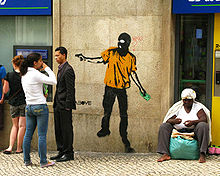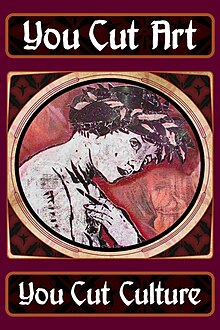
Artivism is a portmanteau word combining art and activism, and is sometimes also referred to as Social Artivism.
History



The term artivism in US English has its roots in a 1997 gathering of Chicano artists from East Los Angeles and the Zapatistas in Chiapas, Mexico. The words "Artivist" and "Artivism" were then popularized through a variety of events, actions and artworks via artists and musicians such as Quetzal, Ozomatli, and Mujeres de Maiz, among other East Los Angeles artists, and at spaces such as Self Help Graphics & Art.
Artivism further developed as antiwar and anti-globalization protests emerged and proliferated. In many cases artivists attempt to push political agendas by the means of art, but a focus on raising awareness of social, environmental, and technological problems is also common.
Besides using traditional mediums like film and music to raise awareness or push for change, an artivist can also be involved in culture jamming, subvertising, street art, spoken word, protesting, and activism. Since 2013, Cromoactivismo, a Brazilian group of women artists, works with collectives, groups and schools in direct actions using color for social change.
Artivist Eve Ensler stated:
... This passion has all the ingredients of activism, but is charged with the wild creations of art. Artivism—where edges are pushed, imagination is freed, and a new language emerges altogether." Bruce Lyons has written: "... artivism ... promotes the essential understanding that ... ... can, through courageous creative expression, experience the unifying power of love when courage harnesses itself to the task of art + social responsibility.
By 2005, the term had made its way into academic writing when Slovenian theatre scholar Aldo Milohnic used the term to discuss "autonomous ('alter-globalist', social) movements in Slovenia that attracted wide attention. In carrying out their political activity they made use of protests and direct actions, thereby introducing the 'aesthetic', willingly or not". In 2008, Chela Sandoval and Guisela Latorre published a piece on Chicano/a artivism and M. K. Asante using the term in reference to Black artists.
There is a chapter on artivism in the book It's Bigger Than Hip Hop by M. K. Asante. Asante writes of the artivist:
The artivist (artist + activist) uses their artistic talents to fight and struggle against injustice and oppression—by any medium necessary. The artivist merges commitment to freedom and justice with the pen, the lens, the brush, the voice, the body, and the imagination. The artivist knows that to make an observation is to have an obligation.
The impact of artivism vs. conventional activism was tested in a public scientific experiment in Copenhagen, Denmark, in 2018. The results, reported in the journal of Social Movement Studies, suggest that artivism may be more effective than conventional activism.
The Inaugural Global Artivism Conference took place in Tshwane, South Africa, from September 5-8, 2024.
Artivists
Notable artivists and self-identified artist-activists include:
- Above
- Ai Weiwei
- Aja Monet
- Alfredo Meschi
- Aloe Blacc
- Annie Sprinkle
- Anomie Belle
- Banksy
- Bleepsgr
- Bordalo II
- Daniel Arzola
- David Wojnarowicz
- Deborah De Robertis
- Deeyah Khan
- Donald "C-Note" Hooker
- Ernest Zacharevic
- Favianna Rodriguez
- Fredericka Foster
- Gianluca Costantini
- Guillermo Gómez-Peña
- JoFF Rae
- JR
- Jeanmarie Simpson
- Judy Baca
- Julio Salgado
- Kwame Akoto-Bamfo
- Las Cafeteras
- Lila Downs
- Lost Children of Babylon
- Lydia Canaan
- Lynnette Haozous
- Martha Gonzalez
- Marina DeBris
- Martin Aveling
- Maya Jupiter
- Michel Platnic
- Milo Moiré
- Norm Magnusson
- Pavel 183
- Peter Joseph
- Quetzal (band)
- Qween Jean
- Reverend Billy and the Church of Stop Shopping
- Sabo_(street_artist)
- Saul Williams
- Self Help Graphics & Art
- Tania Bruguera
- Tinkebell
- Valie Export
- Walela Nehanda
- Parimah Avani
- Weapons of Mass Creation
- Will St Leger
Collectives and organizations
Artivists often work in interdisciplinary collectives that are stand-alone' or operate as a creative part of the greater activist groups, such as Gran Fury of AIDS Coalition to Unleash Power (ACT UP). Other groups include:
- Artivist Film Festival
- Crass
- Da! collective
- The Fearless Collective
- Gran Fury
- Guerrilla Girls
- Riky Rick Foundation for the Promotion of Artivism
- Sol Collective
- The Yes Men
See also
- The arts and politics
- Graffiti
- Hacktivism
- Invisible theater
- Satire
- Social center
- Timeline of Extinction Rebellion actions
- Whirl-Mart
- Brooklyn Immersionists
References
- ^ Politics, Power and Passion, The New York Times, December 2, 2011. Please see the fifth segment by Eve Ensler.
- ^ Jeanmarie Simpson -- Artivist in the Modern Landscape (Part 1), Dylan Brody, The Huffington Post, 2011.10.03
- ^ Jeanmarie Simpson -- Artivist in the Modern Landscape (Part 2), Dylan Brody, The Huffington Post, 2011.10.05
- "Graphic Outbreak 5. The Poetic Activism of Colour". museoreinasofia.es/en. Museo Nacional Centro de Arte Reina Sofía. Retrieved 5 February 2024.
- Bell, Vanessa. "Color commentary: How Cromoactivismo uses the power of hue to challenge invisible systems". Art Basel. Retrieved 5 February 2024.
- "ARTIVISM". transversal texts. Retrieved 2022-11-20.
- Chela Sandoval and Guisela Latorre, ""Chicana/o Artivism: Judy Baca's Digital Work with Youth of Color," in Learning Race and Ethnicity, MIT Press, 2007.
- M.K. Asante, Jr. It's Bigger Than Hip Hop, St. Martin's Press, 2009.
- Duncombe, Stephen; Harrebye, Silas (2021-09-08). "The Copenhagen Experiment: testing the effectiveness of creative vs. conventional forms of activism". Social Movement Studies. 21 (6): 741–765. doi:10.1080/14742837.2021.1967125. ISSN 1474-2837. S2CID 239223880.